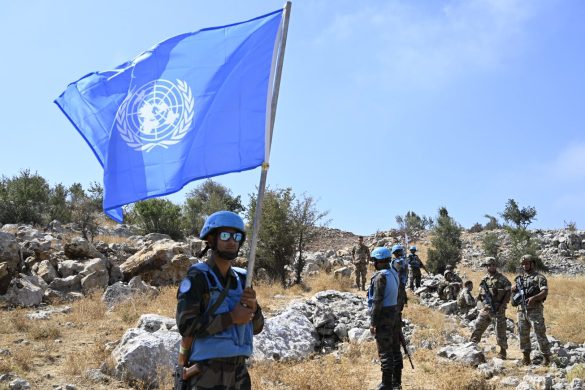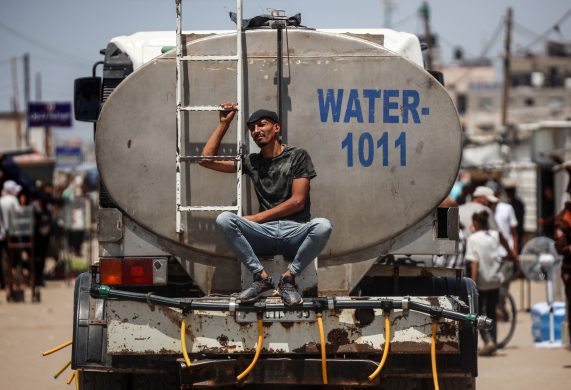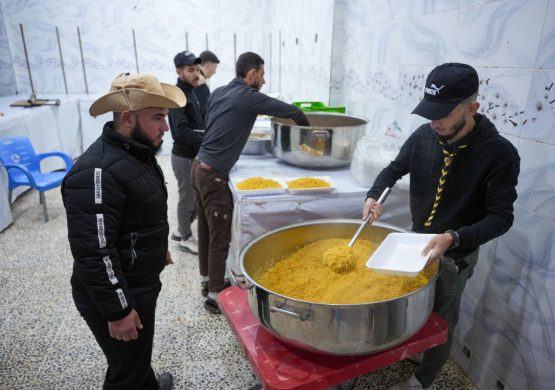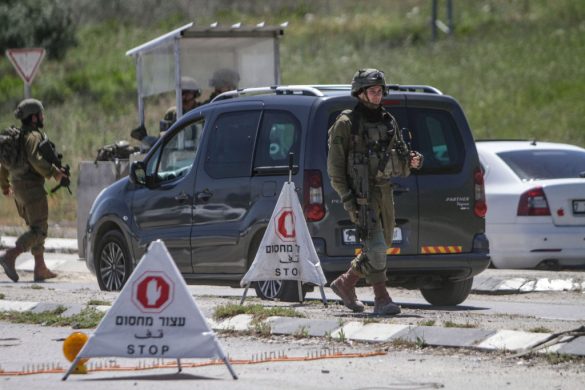Det er blevet meget sværere at levere fødevarehjælp til Gaza efter lukningen af Karni passagen den 2. marts, siger FN. Over halvdelen af befolkningen i Gaza skønnes at være ramt af fødevaremangel.
Det bliver også ca. 20 procent dyrere at yde bistand, siger Chris Gunness fra FNs Hjælpeorganisation for Palæstina-flygtinge (UNRWA) i Jerusalem til nyhedsbureauet IRIN.
UNRWA har allerede et budgetunderskud på over 50 millioner dollars.
Omkring 750.000 palæstinensere ud af 1 million flygtninge i Gaza modtager UNRWA fødevarehjælp.
Karni passagen, der kontrolleres af Israel, er den eneste kommercielle overgang, der har faciliteter til at klare gennemkørsel af store lastbiler, der skal ind i Gaza.
I juni 2007 lukkede de israelske myndigher for lastbiler, men det var stadigt muligt at overføre korn. Det er det ikke længere. Den 2. marts lukkede overgangen helt og nødhjælpen på nu leveres på andre mere kostbare og besværlige måder.
Brug af mindre overgange
Kerem Shalom, a smaller commercial crossing at the southernmost point on the Gaza-Israel border, lacks facilities to allow large numbers of trucks to enter Gaza, according to the UN Office for the Coordination of Humanitarian Affairs (OCHA). It is now the only point where humanitarian and commercial supplies can enter Gaza.
“Kerem Shalom crossing does not have the capacity to meet Gaza’s needs, and there must be more than one operational crossing to import humanitarian and commercial supplies for Gaza’s 1.5 million people,” said UNRWA spokesperson Gunness. “Forcing humanitarian organizations through the bottleneck of Kerem Shalom will do little to relieve the humanitarian suffering of the people of Gaza.”
He added that supplies to Gaza were still at about 40 percent of pre-June 2007 levels.
Færre lastbiler
Maj Guy Inbar, Israeli coordinator of government activities in the (Palestinian) territories (COGAT), told IRIN COGAT had decided to move the conveyor belt from Karni to Kerem Shalom.
“Only the conveyor belt at Karni had been operating two days per week, due to security concerns, to enter grain and aggregates [building materials],” said Inbar, “and moving the belt will increase the number of days it can operate per week and the types of goods that can enter.”
Kerem Shalom has a capacity of 300 trucks per day, but due to “limited Palestinian requests”, an average of 170-180 trucks enter Gaza daily, he added.
“If Israel closes Karni crossing, using the conveyor belt at Kerem Shalom to enter supplies, it is expected that it will be more expensive due to higher fees and the greater distance trucks must drive to reach the crossing,” Jean-Noel Gentile, head of the World Food Programme (WFP) in Gaza, told IRIN. The agency provides food assistance to an average of 313,000 non-refugee beneficiaries in Gaza.
“The main factors contributing to food insecurity in Gaza are lack of purchasing power and rising food prices, and an economy relying almost entirely on public sector and humanitarian assistance,” said Gentile. “There is no sustainable growth in the present conditions in the Gaza Strip because of the blockade,” he added.
Israel tightened its blockade of Gaza, due to security concerns, after Hamas seized control of the territory in 2007. Through prolonged border closures Israel has restricted the import of fuel and commercial goods, as well as most construction and raw materials, reports OCHA.
Meanwhile, Gaza’s unemployment rate hovers at 50 percent, according to the Palestinian Central Bureau of Statistics (PCBS).
Mangel på proteiner
Samia Afaneh, a 40-year-old refugee from the Sheikh Radwan area of Gaza City, and her family of 10, receive food assistance from UNRWA every three months, including flour, cooking oil, powdered milk and sugar.
Samia’s husband used to work at an Israeli crossing, but since the blockade was tightened he is unemployed. “Even with the assistance, my children are still undernourished,” she said. “I was diagnosed with anaemia when I was pregnant, and so was one of our daughters.”
Samia said her family could not afford protein-rich foods. “We can only afford one kilogram of fish or two chickens per month to feed 10 people,” she said.
WFP is collecting information at the household level for a report due in May that will explore if Israel’s easing of its blockade since June 2010 had affected prices, food availability and livelihoods in Gaza.
Since the easing of the blockade, Israel has allowed a limited amount of building materials to enter Gaza. Israel has approved 43 UNRWA projects, worth 11 percent of the total work plan submitted by the agency, reports OCHA.
“Since the second half of 2010 some aggregates have been allowed to enter Gaza via Karni crossing, but the number of opening days of the crossing is not great enough to enter both the aggregates and sufficient supplies of wheat grain and animal feed,” said Gentile of WFP.
Højere fødevarepriser
There is not enough wheat in Gaza and this affects delivery of food assistance to nearly one million beneficiaries by UNRWA and WFP, which usually purchase flour from local mills. Dependency of the poorest on food assistance has increased in recent months due to a sharp increase in the market price of wheat flour (by some 50 percent since August 2010), reports OCHA.
In the second half of 2010, the food consumer price index (CPI) in the West Bank and Gaza spiked as a reflection of soaring food prices in the international market, said the Palestinian Authority (PA). Such trends are expected to extend into 2011, and while the CPI is rising, income levels and purchasing power in Gaza are decreasing.
Given that expenditure on food accounts for 60 percent of total household expenditure, and with current levels of food insecurity in Gaza at 52 percent, a continuing increase in food prices on the current scale will push hundreds of thousands more Palestinians into poverty and food insecurity, the PA warned.
Between 2007 and 2009 there was a dramatic increase in food cash expenditure – by 67 percent in the Gaza Strip – out of total cash expenditure, while the amount of caloric intake is decreasing, according to PCBS. Between 2007 and 2009 the caloric intake per capita in Gaza and the West Bank decreased by 18 percent, PCBS says.
Abdel Salibi, 70, from Beach Camp in Gaza City, and his family of five, receive food assistance from UNRWA. “Our family can only afford to buy meat products every few months,” Abdel said.
“The roof of our home near the beachfront, is still damaged from the war [Israel’s 23-day offensive in Gaza ending in January 2009] when Israeli gunboats would fire at the camp,” he said, since building materials are scarce on the local market.














